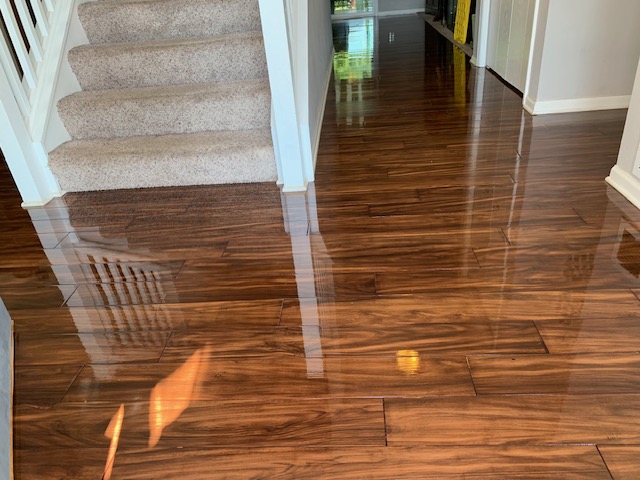Refinishing Floors Without Sanding

Hardwood floors are a classic and timeless addition to any home. Their beauty, durability, and the value they add to a property are unmatched. However, as time passes, even the most carefully maintained hardwood floors will start to show signs of wear. This can include scuffs, scratches, fading, and discoloration, all of which can detract from the natural beauty of the wood. While the idea of refinishing might seem daunting, particularly when you think of the noise and mess associated with sanding, many homeowners wonder: Can you refinish hardwood floors without sanding? Yes you can refinish hardwood floors without sanding.
At Choice Hardwoods, we understand that refinishing hardwood floors can seem like a big job. However, there are more efficient methods available that involve less disruption. One of these methods is called a screen and coat (also known as a buff and coat). But how does this process work, and is it the right option for your hardwood floors? Let’s break it down.
What Is a Screen and Coat?
A screen and coat is a technique that involves lightly abrading the existing finish on your hardwood floors without fully sanding them down. The purpose of this process is to roughen the surface of the existing polyurethane or other finish, allowing a new layer of finish to adhere to the surface.
It is a quick and relatively low-mess method compared to traditional sanding, but it’s important to note that screeningdoes involve some mild abrasion. During the process, a special tool with a mesh screen (hence the name) is used to lightly sand the top layer of finish. This abrades the existing poly enough so that a fresh coat of polyurethane or other finish can adhere properly, without fully stripping down the floor to the raw wood.
Once the surface is lightly abraded, the floor is cleaned to remove any debris or dust, and then a new protective coat of finish is applied. The new finish helps to restore the floor’s shine, fill in minor imperfections, and generally improve its appearance.
This process is often recommended for floors that don’t need full refinishing but have just started to show signs of wear. It’s a less invasive, faster, and more cost-effective alternative to traditional sanding and refinishing.
What Does Screen and Coat Fix—and What Doesn’t It Fix?
While a screen and coat can help restore the shine and improve the appearance of hardwood floors, it’s important to understand its limitations. A screen and coat can improve the finish of your floors, but it cannot correct deeper issues like discoloration, dents, or wear patterns.
Here’s a closer look at what a screen and coat can and cannot fix:
What It Can Fix:
-
Minor Surface Scratches and Scuffs:
The most obvious improvement that a screen and coat offers is the reduction of minor surface scratches, scuffs, and imperfections. The new layer of finish can fill in small gouges and help even out the floor’s appearance. The screen and coat process makes the scratches less noticeable, giving the floor a smoother look. -
Loss of Shine:
Over time, hardwood floors tend to lose their luster due to foot traffic, dust, and the natural degradation of the protective finish. A screen and coat will bring back that glossy, reflective shine that makes hardwood floors so appealing. -
Light Wear and Tear:
If the floors are only showing light wear—such as dullness or slight scratching—screening and coating can provide a rejuvenated look without the hassle of a full sanding job. The process will add a layer of protection, preventing further damage while restoring some of the floor’s original beauty.
What It Cannot Fix:
-
Deep Scratches, Dents, or Gouges:
If your floors have deeper damage, such as large scratches, dents, or gouges, a screen and coat will not fix these issues. The process only affects the topmost layer of the finish and will not address deeper imperfections in the wood itself. These issues would require a full sanding to restore the floor’s smoothness. -
Discoloration and Stains:
While a screen and coat can restore the overall sheen of the floor, it won’t fix discoloration caused by water damage, sun fading, or other factors. If your floors have areas with significant staining or fading, a full sanding and refinishing job would be required to fully restore the natural color of the wood. -
Uneven Wear Patterns:
If your floors have areas of wear where the finish has worn down unevenly due to heavy foot traffic or furniture placement, the screen and coat will not correct these uneven patterns. The new finish will not be able to fill in these patterns, and they will still be visible after the process is complete. -
Heavy Damage from Pets or Furniture:
If your floors are scratched up from pets or the edges have been damaged by furniture, a screen and coat will only hide minor imperfections. For substantial damage from claws, heavy furniture, or high-traffic areas, full refinishing is the only way to truly restore the appearance of the floor.
When Is a Screen and Coat the Right Choice?
A screen and coat is ideal for hardwood floors that are in relatively good condition, but simply need some touch-ups. If your floors are showing minor surface scratches, dullness, or a loss of shine, this process can give them a fresh look without the hassle and expense of a full sanding job. This method is perfect if:
- The floors have been regularly maintained and still have a solid, intact finish.
- There’s no significant discoloration, deep scratches, or damage that would require sanding down to raw wood.
- The wood is still structurally sound and there are no signs of warping or moisture damage.
- You’re looking for a quicker, less expensive alternative to a complete sand and refinish.
However, if your floors are worn, scratched, or damaged to the point where the wood itself is affected, a full sanding and refinishing job may be necessary. This is especially true for floors that have seen heavy use or are in need of significant restoration.
What Types of Floors Can a Screen and Coat Be Done On?
Not all hardwood floors are suitable for a screen and coat. It’s important to assess the condition of your floors before deciding if this process is right for you. Here are some general guidelines for which floors are good candidates for a screen and coat:
Floors That Are Suitable for a Screen and Coat:
-
Floors with a Solid Finish:
For a screen and coat to be successful, the floor must have a solid, intact finish. If your floors are already stripped down to raw wood or if the finish is completely worn away in certain areas, screening and coating will not work. The process relies on the existing finish providing a base for the new layer to adhere to. -
Floors with Minor Wear:
As mentioned earlier, a screen and coat is best for floors with only light to moderate wear. If the wear is limited to surface scratches, dullness, or slight fading, the process can effectively restore the floor’s appearance. -
Floors That Have Been Properly Maintained:
If your floors have been regularly cleaned and polished, with no significant water damage or staining, a screen and coat is a great option. Regular maintenance preserves the finish, allowing for a fresh coat of polyurethane to adhere properly. -
Floors with Polyurethane or Other Durable Finishes:
The screen and coat technique works best on floors that have a polyurethane finish or other similar finishes. These finishes provide a durable protective layer that can be sanded lightly to allow new finish to bond properly.
Floors That Are Not Suitable for a Screen and Coat:
-
Floors with Significant Water Damage:
If your floors have been exposed to water damage—such as from a leak or spill—you may see warping, cupping, or discoloration. A screen and coat will not correct these issues, and in most cases, you’ll need a full sanding and refinishing job to address the problem properly. -
Floors with Extensive Scratches or Gouges:
For floors that have deeper scratches or gouges that have reached the wood itself, a screen and coat won’t help. These floors need to be sanded down to remove the damaged layers and allow for a fresh start. -
Floors with Wax or Oil Finishes:
If your floors have a wax or oil-based finish, a screen and coat is not recommended. These finishes don’t provide a solid enough surface for the new coat to adhere properly, and the result may be uneven or ineffective. Waxed floors typically require a complete sanding and refinishing to switch to a polyurethane or other durable finish. -
Floors with Heavy Discoloration or Uneven Fading:
If your floors have significant discoloration, sun damage, or faded areas due to exposure to UV light, a screen and coat will not be able to fix these issues. A full sand and refinish would be necessary to restore the uniform appearance of your hardwood floors.
Full Sand and Refinish vs. Screen and Coat
While a screen and coat is a great option for many homeowners, it’s important to understand that most floors will need a full sand and refinish if they are more than just slightly worn. If your floors are showing significant signs of damage, deep scratches, discoloration, or wear patterns, the best course of action is to have them fully sanded down and refinished.
A full sanding removes the old finish entirely, and can even address deeper issues like gouges, stains, and unevenness. It allows the wood to be restored to its natural beauty, and it gives you the option to change the color of the stain if desired. For heavily worn floors or floors with substantial damage, a full refinishing is the only way to bring them back to life.
Conclusion
At Choice Hardwoods, we understand that choosing the right refinishing method for your hardwood floors can be confusing. While a screen and coat can be a great option for floors with light wear and tear, it’s not a one-size-fits-all solution. This process works best on floors with intact finishes that have only experienced minor scratches or fading. For floors that are more damaged, discolored, or have deep wear, a full sanding and refinishing will be necessary.
If you’re unsure whether your floors are a good candidate for a screen and coat, our team of experts at Choice Hardwoods can help. We’ll assess your floors, evaluate their condition, and guide you through the best options to restore their beauty and durability.
Refinishing your hardwood floors, whether through a screen and coat or a full sand and refinish, is an investment in your home’s value and aesthetic appeal. Let us help you make the right choice for your floors today!

